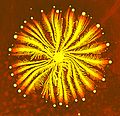Paenibacillus
Genus of bacteria
Paenibacillus is a genus of Gram-positive bacteria that are known for their diverse metabolic capabilities and ecological roles. Members of this genus are found in a variety of environments, including soil, water, and plant surfaces. They are notable for their ability to degrade complex organic compounds and for their role in nitrogen fixation.
Characteristics
Paenibacillus species are typically rod-shaped and can form endospores, which allow them to survive in harsh environmental conditions. They are facultative anaerobes, meaning they can grow in both the presence and absence of oxygen. The genus is characterized by its ability to produce a wide range of enzymes, including cellulases, xylanases, and chitinases, which enable them to break down complex polysaccharides.
Cell Structure and Metabolism
Paenibacillus cells are generally motile, possessing flagella that allow them to move. They exhibit a wide range of metabolic activities, including the ability to fix nitrogen, which is crucial for plant growth. This makes them important in agriculture as biofertilizers. Some species are also known to produce antimicrobial compounds, which can inhibit the growth of plant pathogens.
Genomic Features
The genome of Paenibacillus species is relatively large compared to other bacteria, reflecting their diverse metabolic capabilities. Genomic studies have revealed genes responsible for the production of antibiotics, enzymes, and other secondary metabolites. The presence of these genes highlights the potential of Paenibacillus as a source of novel bioactive compounds.
Ecological Role
Paenibacillus species play a significant role in the decomposition of organic matter in soil ecosystems. By breaking down complex carbohydrates, they contribute to the recycling of nutrients, enhancing soil fertility. Their ability to fix nitrogen also supports plant growth, making them valuable in sustainable agriculture practices.
Applications
Due to their enzymatic capabilities, Paenibacillus species are used in various industrial applications. They are employed in the production of biofuels, biopesticides, and biodegradable plastics. Their role in bioremediation is also being explored, as they can degrade pollutants such as hydrocarbons and heavy metals.
Pathogenicity
While most Paenibacillus species are beneficial, some can be opportunistic pathogens. For example, Paenibacillus larvae is the causative agent of American foulbrood, a serious disease affecting honeybee larvae. Understanding the pathogenic mechanisms of these species is important for managing their impact on agriculture and apiculture.
Research and Future Directions
Ongoing research on Paenibacillus focuses on exploring their genetic diversity and potential applications in biotechnology. Advances in genomics and metagenomics are providing insights into their ecological roles and capabilities. Future studies aim to harness their metabolic potential for sustainable solutions in agriculture and industry.
Also see
Paenibacillus
Transform your life with W8MD's budget GLP-1 injections from $125.
W8MD offers a medical weight loss program to lose weight in Philadelphia. Our physician-supervised medical weight loss provides:
- Most insurances accepted or discounted self-pay rates. We will obtain insurance prior authorizations if needed.
- Generic GLP1 weight loss injections from $125 for the starting dose.
- Also offer prescription weight loss medications including Phentermine, Qsymia, Diethylpropion, Contrave etc.
NYC weight loss doctor appointments
Start your NYC weight loss journey today at our NYC medical weight loss and Philadelphia medical weight loss clinics.
- Call 718-946-5500 to lose weight in NYC or for medical weight loss in Philadelphia 215-676-2334.
- Tags:NYC medical weight loss, Philadelphia lose weight Zepbound NYC, Budget GLP1 weight loss injections, Wegovy Philadelphia, Wegovy NYC, Philadelphia medical weight loss, Brookly weight loss and Wegovy NYC
|
WikiMD's Wellness Encyclopedia |
| Let Food Be Thy Medicine Medicine Thy Food - Hippocrates |
Medical Disclaimer: WikiMD is not a substitute for professional medical advice. The information on WikiMD is provided as an information resource only, may be incorrect, outdated or misleading, and is not to be used or relied on for any diagnostic or treatment purposes. Please consult your health care provider before making any healthcare decisions or for guidance about a specific medical condition. WikiMD expressly disclaims responsibility, and shall have no liability, for any damages, loss, injury, or liability whatsoever suffered as a result of your reliance on the information contained in this site. By visiting this site you agree to the foregoing terms and conditions, which may from time to time be changed or supplemented by WikiMD. If you do not agree to the foregoing terms and conditions, you should not enter or use this site. See full disclaimer.
Credits:Most images are courtesy of Wikimedia commons, and templates, categories Wikipedia, licensed under CC BY SA or similar.
Contributors: Prab R. Tumpati, MD



